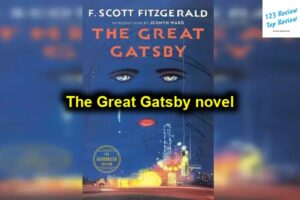Published in 2000, the novel masterfully blends historical fiction with an exploration of personal and cultural identity, all against the backdrop of the Golden Age of comic books and the turbulent events of World War II. At its core, it tells the story of two Jewish cousins, Josef Kavalier and Samuel “Sammy” Clayman (later Clay), who collaborate to create The Escapist, a superhero who embodies freedom, resistance, and the power to break free from oppression. Through Chabon’s evocative prose, the novel delves deeply into themes of escape, illusion, immigrant experience, and the role of art in times of crisis.

Critical Reception
Awards and Honors
The Amazing Adventures of Kavalier & Clay was met with widespread acclaim upon its release, cementing Michael Chabon as a prominent voice in modern fiction. One of the novel’s most significant achievements was winning the Pulitzer Prize for Fiction in 2001. This recognition placed the novel at the forefront of American literary discourse, but it was not the only accolade Chabon received. The book was also a finalist for the PEN/Faulkner Award for Fiction and the National Book Critics Circle Award, further underscoring its impact. Its reach extended beyond the literary community, as it gained a passionate following among readers and comic book enthusiasts alike.
Reviews from Literary Critics
Critics from esteemed publications universally praised Kavalier & Clay for its innovative storytelling, deep characterization, and seamless integration of historical events. The New York Times called it “a novel of towering achievement,” and lauded Chabon’s ability to depict the grandeur and chaos of mid-20th-century America, particularly through the lens of Jewish identity and comic book culture. The Guardian emphasized the richness of Chabon’s prose, describing his style as “an exuberant tapestry of language, bursting with color and imagination.” Many literary critics also appreciated the novel’s structure, which employed flashbacks, historical interludes, and introspective character studies.
Reader Testimonials
Reader reviews have consistently mirrored the enthusiasm found in critical circles. Many readers have expressed how the novel resonated with them on personal levels—especially those who share immigrant backgrounds or connections to Jewish heritage. Josef’s escape from Nazi-occupied Prague and Sammy’s struggle with his identity as a gay man in 1940s America struck a chord with readers who saw elements of their own struggles reflected in the story. Furthermore, comic book fans embraced the novel for its meticulous depiction of the early comic book industry, which gave insight into the creative processes behind some of the most iconic superheroes in American culture.
Themes and Motifs
The Immigrant Experience
Central to the novel is Josef Kavalier’s journey as a Jewish refugee who flees his homeland of Czechoslovakia to escape Nazi persecution. Chabon paints a vivid picture of Josef’s life before his escape, portraying the fear, loss, and isolation felt by so many Jews during the Holocaust. The novel explores the emotional and psychological toll of leaving behind family, culture, and identity in the quest for survival. Josef’s eventual arrival in America presents a new set of challenges as he grapples with guilt, displacement, and the weight of his homeland’s destruction. Through Josef, Chabon captures the universal immigrant experience—the hope for a better future mixed with the pain of what is left behind.
Illusion and Escape
The motif of escape is woven throughout the narrative in both literal and symbolic ways. Josef’s training in magic and escapology under a master magician in Prague serves as a powerful metaphor for his attempts to escape the horrors of the Holocaust and the confines of his past. His ability to free himself from physical restraints mirrors his deep desire to transcend the psychological chains of trauma. Sammy Clay, too, seeks an escape—though his is from the limitations imposed by society, both as an aspiring writer and as a closeted gay man in a repressive era.
Moreover, the creation of The Escapist, the cousins’ comic book superhero, epitomizes the theme of escape. As a character who can free himself from any bind and defeat tyranny, The Escapist becomes a symbol of hope and freedom, not only for the characters but also for readers of the era who yearned for a sense of control in the face of global chaos.
Superhero Identity and Cultural Reflection
The superhero genre itself becomes a lens through which Chabon examines American culture, especially in the 1940s and 1950s. Superheroes in Kavalier & Clay are more than just fictional characters—they are cultural icons that reflect societal ideals, anxieties, and aspirations. The Escapist represents the triumph of good over evil, the possibility of breaking free from oppression, and the power of individual agency. These themes resonate with Josef and Sammy, who see their own struggles mirrored in the pages of the comic books they create. The novel also comments on how the comic book industry offered a form of escapism to a war-weary American public, while simultaneously providing a medium for addressing real-world issues such as fascism, racism, and the fight for justice.
Character Analysis
Josef Kavalier
Josef Kavalier is a complex and multi-dimensional character whose personal journey forms the emotional core of the novel. As a talented artist and an apprentice to a stage magician, Josef’s background in escapology serves as both a literal and metaphorical representation of his desire to break free from the trauma of his past. His escape from Prague to New York, smuggled in a coffin, is one of the novel’s most harrowing and defining moments, setting the stage for his lifelong struggle with survivor’s guilt. Throughout the novel, Josef grapples with his inability to save his family from the horrors of the Holocaust, which leads him into a life of obsession, anger, and eventually, a desperate quest for redemption.
His artistic contributions to the creation of The Escapist allow Josef to channel his emotional turmoil into something productive and meaningful. However, even as he achieves success, he remains haunted by his past, unable to fully embrace his new life in America. His character arc is one of deep inner conflict, as he constantly oscillates between hope and despair, creation and destruction, love and loss.
Sammy Clay
Sammy Clay, Josef’s cousin, is equally compelling, though his struggles are of a different nature. While Josef is consumed by the trauma of his past, Sammy’s primary challenge is his search for personal identity and acceptance in a world that marginalizes him. As a closeted gay man in the 1940s, Sammy lives in fear of societal rejection, which shapes much of his internal conflict. Despite his ambition and talent as a writer, he often feels trapped by the limitations imposed on him by both his family and society at large.
Sammy’s relationship with Josef is central to the narrative, as their collaboration on The Escapist represents more than just a professional partnership—it is a shared dream of escape and reinvention. Sammy’s unfulfilled romantic relationships and his struggle to reconcile his sexuality with societal norms add layers of complexity to his character, making him a poignant figure of repression and yearning.
Supporting Characters and Their Roles
The supporting characters in Kavalier & Clay add depth to the novel’s exploration of family, love, and artistic ambition. Rosa Saks, Josef’s love interest and eventual wife, is a crucial figure whose relationship with both Josef and Sammy reveals much about their emotional landscapes. Rosa is a symbol of stability and warmth, yet she too is burdened by the weight of the war and its aftermath. Her role in the novel highlights themes of sacrifice, love, and the enduring impact of trauma.
Other supporting characters, such as industry insiders from the comic book world, serve to highlight the pressures and struggles faced by creators in an emerging field. Their interactions with Josef and Sammy offer insight into the evolving landscape of American pop culture during this period.
Historical Context
Impact of World War II
The shadow of World War II looms large over the entire novel, influencing both the characters’ personal lives and the broader societal context in which the story unfolds. The war shapes Josef’s journey from the very beginning, as he narrowly escapes Nazi-occupied Prague, leaving behind his family and grappling with the horrors unfolding in Europe. As news of the Holocaust and the war continues to filter through the novel, it serves as a constant reminder of the stakes involved—both for Josef personally and for the world at large.
The war also impacts the comic book industry, as superheroes like The Escapist become symbols of resistance against fascism. Chabon expertly weaves real-world events into the narrative, reflecting how art, literature, and popular culture responded to and were shaped by global conflict.
Jewish Identity and Anti-Semitism
Jewish identity is a central theme in Kavalier & Clay, with both Josef and Sammy grappling with different aspects of their heritage. Josef’s Jewishness is inextricably linked to his experiences as a refugee, as he carries with him the trauma of the Holocaust and the loss of his family. His identity is tied not only to his past in Prague but also to his desire to preserve a sense of Jewish culture and resilience in a world that seems determined to erase it.
Sammy, meanwhile, experiences anti-Semitism in America, though his struggles with Jewish identity are less pronounced than Josef’s. Chabon uses both characters to explore the varied experiences of Jews during this time period, highlighting the different ways in which Jewishness could be both a source of pride and a target for discrimination.
The Comic Book Industry Evolution
The novel provides a rich portrayal of the Golden Age of comic books, a time when superheroes were on the rise and comic books became a dominant form of entertainment. Chabon’s depiction of this industry is deeply informed by real-life figures such as Jerry Siegel and Joe Shuster, the creators of Superman, and the novel’s fictional comic book creators, Josef and Sammy, mirror their struggles and triumphs.
Through their work on The Escapist, Chabon explores how comic books offered not just escapism but also a means of processing and reflecting on the real-world issues of the time. The novel also comments on the exploitation and lack of recognition that many comic book creators faced during this period, as the industry rapidly commercialized and evolved.
Narrative Structure
Storytelling Techniques
Chabon’s narrative techniques in The Amazing Adventures of Kavalier & Clay are both innovative and effective. He skillfully blends historical fiction with elements of magical realism, grounding the story in the harsh realities of World War II while also allowing for moments of whimsy and escapism. Chabon’s rich, descriptive prose brings the world of 1940s New York to life, while his use of historical figures and events provides a sense of authenticity and immersion.
One of the novel’s standout features is its ability to shift between different tones and genres. At times, it reads like a historical epic, while at others it takes on the tone of a comic book adventure or a psychological drama. This genre-blending adds depth and complexity to the narrative, allowing Chabon to explore a wide range of themes and emotions.
Use of Flashbacks
Flashbacks are a key storytelling device in Kavalier & Clay, particularly in the sections that deal with Josef’s life before his escape from Prague. These flashbacks provide crucial context for Josef’s actions and motivations, giving the reader insight into the trauma and loss that shape his character. The use of flashbacks also allows Chabon to explore the larger historical context of the novel, particularly the rise of Nazi power and the escalating horrors of the Holocaust.
Pacing and Development
Spanning several decades, the novel covers a vast array of events, from the creation of The Escapist and the rise of Josef and Sammy’s comic book careers, to the devastating impact of World War II and its aftermath. Chabon expertly balances the pacing, ensuring that the novel’s intimate character moments are given as much attention as its larger historical events. The narrative unfolds gradually, allowing readers to fully invest in the characters’ emotional journeys while also appreciating the broader historical and cultural shifts taking place around them.
Symbolism
The Escapist Character
The Escapist, Josef and Sammy’s superhero creation, serves as one of the novel’s most potent symbols. As a character who can break free from any restraint and triumph over tyranny, The Escapist embodies the theme of freedom and resistance. For Josef, The Escapist represents his own desire to escape the trauma of his past and the guilt he feels over leaving his family behind in Prague. For Sammy, The Escapist offers a means of expressing his frustrations with societal constraints and his yearning for personal freedom.
Magic and Performance
Magic and illusion are recurring motifs throughout the novel, particularly in relation to Josef’s training as an escapologist. Magic serves as a metaphor for control—Josef’s ability to perform escapes represents his desire to control his own fate and defy the forces that seek to confine him. The novel also explores the idea of performance, both in the literal sense of stage magic and in the figurative sense of the roles that the characters play in their own lives. Whether it’s Josef’s attempts to reinvent himself in America or Sammy’s struggles to conform to societal expectations, the idea of performance is central to the characters’ development.
The Empire State Building as a Metaphor
The Empire State Building, a towering symbol of American ambition and industrial power, plays a significant role in the novel, particularly in the context of Josef and Sammy’s dreams. For them, the Empire State Building represents the heights they aspire to reach in both their personal and professional lives. It is a symbol of the American Dream—an ideal that is both inspiring and elusive. The building’s presence in the novel serves as a constant reminder of the characters’ ambitions, as well as the challenges they face in trying to achieve them.
Personal Reflections
Author’s Background
Michael Chabon’s personal connection to the material is evident throughout Kavalier & Clay. As a Jewish American and a lifelong fan of comic books, Chabon brings a deep understanding of both the cultural and historical contexts of the novel. His passion for comic books is reflected in the meticulous detail with which he portrays the comic book industry, while his Jewish heritage informs the novel’s exploration of identity, trauma, and resilience.
Chabon’s own experiences as a writer struggling to balance artistic integrity with commercial success are also reflected in the characters of Josef and Sammy. Their journey through the comic book industry mirrors the challenges faced by many artists, particularly those working in fields that are often seen as less “serious” or respected by the literary establishment.
Influence on Pop Culture
Since its publication, The Amazing Adventures of Kavalier & Clay has had a profound impact on both the literary world and popular culture. The novel’s exploration of the Golden Age of comic books has helped reignite interest in this era, particularly among readers who may not have been familiar with the origins of the superhero genre. Chabon’s depiction of comic book creators as both artists and cultural commentators has also influenced the way we think about the role of comics in society, elevating the medium to a form of serious artistic expression.
The novel has also inspired adaptations and spin-offs, including a planned film adaptation (which has yet to materialize) and the creation of actual Escapist comics published by Dark Horse Comics. Chabon’s influence can be seen in the resurgence of interest in superhero narratives that engage with deeper themes of identity, resistance, and societal change.
Legacy of the Novel
More than two decades after its publication, The Amazing Adventures of Kavalier & Clay remains a landmark work of fiction. Its timeless themes of freedom, identity, and the power of art to transcend hardship continue to resonate with readers of all ages. The novel’s exploration of the immigrant experience, Jewish identity, and the comic book industry ensures its relevance in both historical and cultural contexts.
Chabon’s ability to craft a narrative that is both intimate and epic in scope has solidified Kavalier & Clay as one of the defining novels of the 21st century. Its legacy endures not only in the literary world but also in the broader landscape of popular culture, where its influence can be seen in everything from superhero films to graphic novels that tackle complex social issues. In the years to come, Kavalier & Clay will undoubtedly continue to inspire readers, creators, and scholars alike.





